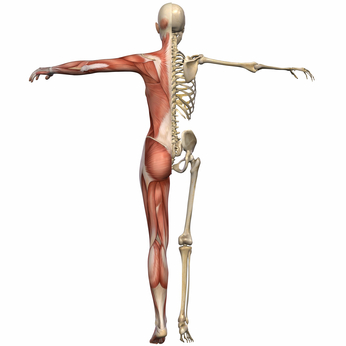Fracture me this: is it time to up your D quotient?
 Too much D is too much of a good thing, isn’t it? But now, data presented a few weeks ago at the American Society of Bone and Mineral annual meeting is turning recommendations on their head, once again. (If you wish to check the evolving data on Vitamin D, take a look at the Flashfree archives here.) The latest conclusion? If you are in menopause, you need to start maintaining high vitamin D levels >20 ng/mL (500 IU) daily to reduce your risk of fracture.
Too much D is too much of a good thing, isn’t it? But now, data presented a few weeks ago at the American Society of Bone and Mineral annual meeting is turning recommendations on their head, once again. (If you wish to check the evolving data on Vitamin D, take a look at the Flashfree archives here.) The latest conclusion? If you are in menopause, you need to start maintaining high vitamin D levels >20 ng/mL (500 IU) daily to reduce your risk of fracture.
As I’ve discussed throughout the years, bone loss increases significantly as levels of estrogen and FSH fluctuate and eventually decline. Moreover, these changes can start as early as age 35 and by the time women reach the age of 50, they have a 40% risk of suffering a fracture due to osteoporosis during the rest of their lifetime. However, in this particular study, which evaluated the role of serum vitamin D in fractures related to falls from standing height or less in women participating in the Study of Women’s Health Across the Nation (SWAN), higher levels of vitamin D were associated with as much as a 45% lower non-traumatic fracture risk compared to levels below the 500 IU daily mark. Additionally, even after the researchers accounted for potential confounding factors, such as the women’s bone mass density and body mass index (BMI), these findings remained. Another important point about this study is that previously, most of the evaluations have been conducted in post menopausal women; this particular group of women were undergoing the menopausal transition. The findings also did not demonstrate any association between vitamin D intake and fractures resulting from traumatic events, such as playing sports or a car accident).
The researchers point out that the underlying role of vitamin D may be its affect on bone quality, adding that they did not set out to measure that so no firm conclusions can be drawn. They also note that they did not see any benefit to upping vitamin D intake between five and one years prior to final menstrual period, meaning that this strategy should be incorporated early on during the pre-menopausal or peri-menopausal years (women between the ages of about 35 to 51, I am talking to you!!!!). Finally, no mention was made of the other risks of high vitamin D intake, such as cardiovascular issues so before you head to your local drugstore, do speak with your health practitioner.
Read MoreFive a day for mental health and wellbeing
Have you been sensing a theme on Flashfree of late? I can’t help gravitating toward stories about mental wellbeing and reducing stress, namely because I have devoted the past few months toward regaining some semblance of balance after years of residing in the opposite flow. And so, once again, I do hope that you’ll allow me to indulge and share some pretty fascinating data:
Eating fruits and vegetables daily is associated with an increased odds of mental wellbeing in both men and women.
Mind you, researchers have not yet proven cause and effect. Yet, the data are pretty compelling! In fact, when British researchers evaluated certain influencing health-related factors in almost 14,000 British respondents participating in the Health Survey for England, they found that consuming (or not consuming) fruits and vegetables daily was the one health behavior that was most consistently associated with both high (and low) mental wellbeing in women and men.
Which other factors did they take into consideration?
Additional health-related behaviors that have been linked to mental health include body mass index, smoking habits and alcohol intake. In this case, Individuals who rated the lowest in terms of mental wellbeing tended to be obese, heavy or ex-smokers, never or ex-drinkers and reported eating the fewest daily servings of fruits and vegetables. Moreover, the the odds for having a lower overall mental wellbeing appeared to have increased exponentially with increasing smoking habits and decreasing fruits and vegetables intake.
Despite these factors, only intake of fruits and vegetables remained relevant and significant for both men and women; different BMI levels or alcohol intake had little bearing. What’s more? These findings tended to be more consistent for women than for men.
Let’s break down the numbers:
- Overall, 33.5% of individuals with high mental wellbeing ate five or more portions of fruits and vegetables daily
- 6.8% of people with the lowest mental wellbeing who reported eating less than one serving daily
- 31.4% with high wellbeing consumed three to four portions daily
- 28.4%of people who ate one to two servings a day had high mental wellbeing
It’s truly linear, isn’t it?
So, what is mental wellbeing?
Think all of everything. It’s more than the absence of mental illness or some sort of psychological issue. Indeed, its implications are huge: mental wellbeing comprises completeness, full-functioning, life satisfaction, optimism, hope, self-esteem, resilience, coping, spirituality and good relationships. Think of the implications should fruits and vegetables be identified as something that actually drives mental wellbeing rather than contributes to it. An easy, enjoyable fix? Five a day? I’d say!!
Read More
Guyside: Fall food thoughts that aren’t hard to swallow.

This may or may not resemble your humble columnist at a barbecue.
Fall is a wonderful season. If you live in a climate where heat and humidity dominate summer, you start to feel relief. Autumn colours make the world beautiful. And (at least for me), food begins to change along with the season.
I love to grill food, and in our household, we take advantage of warm summer days to cook and eat outside as much as we can. But as days get shorter and cooler, we start to move the cooking inside, and that changes the nature of the dishes that get prepared too.
It’s already known that men tend to eat less healthily than women. And It’s really easy for men (and by men I mean me) to enjoy the grilling season a little too much. Sausages, thick steaks, ribs, rich barbecue sauces and the like are great in moderation, but easy to overdo. Even some of the salads I associate with summer have rich dressings that might reduce the benefits of all those healthy veggies. And none of this even begins to address some of the junky food that we eat as the day goes on.
I try to take fall as a sign to revisit what I eat a little bit. I’m not going to go macrobiotic or vegan, but it’s never a bad thing to examine your food choices every so often. Here’s some of the things I do:
- I’m the main cook in our household, so I do a few simple things to make food both good and healthy when shorter days come. I shop from a list, and stock up on basics that I know will get used up over time without going bad. If I’m making a dish that requires some perishable ingredient, I find other dishes to make that will use up that ingredient. For example, I made a pork curry on the weekend that needed ginger root. So during the rest of this week, there’s also a chicken tikka recipe that used ginger root and tonight is pork chops marinated in ginger.
- I try and make some healthy substitutions of ingredients or techniques where I can. Rather than white rice, I’ll use brown rice, or even better, brown basmati rice. Rather than make French fries in a skillet, I do ‘em in the oven. I’ll also switch up sweet potatoes for plain old potatoes. And I try to make things like marinades, dressings, and the like from scratch rather than use store-bought ones. It’s usually cheaper and better.
- The biggest additions to the menu in the fall are soups and slow-cooker meals. Soups or slow-cooker dishes usually mean multiple days are covered, making for stress-free cooking days if my partner and i are busy, and scratch soups are pretty simple to make. Nutritious and delicious works for me.
My big weakness? Lunches. I work from home, so I get to make lunches rather than eat out every day, but my instincts are to have a canned soup (lots of sodium) or a sandwich (processed meat); not always the best choices. So perhaps this fall I’ll try to do better with my lunch choices.
Maybe it’s time for you to take a look at what you cook and eat.
Photo: CC-licenced from the US Marine Corps Archives on Flickr.
Read MoreNewsflash! Got Burnout? Work Stress May Not Paint the Entire Picture
Lord knows, many of us reach that point in our work lives where we simply feel burned out! It’s the underlying reason for underperformance, the reason why we choose to walk away, the cause of stress and unhappiness. I often find myself wondering if there any new information that can help to paint another brushstroke and illuminate the reasons why we feel the way that we do when we reach that peak.
Importantly, according to new research out of the University of Montreal, wellbeing at work can be affected by factors that lay outside the work environment. Mind you, this is not to say that deadlines, relentless demands, abusive colleagues and endless overtime don’t contribute, but findings suggest that these factors are not the sole reasons for psychological distress, depression and emotional exhaustion that provide the framework for the condition that we call burnout.
The researchers explain that workers’ mental health is multifaceted and reliant upon the broader social environment with which they interact on a daily basis. Although these interactions may be sources of wellbeing and pleasure, they can also affect so-called ‘psychic balance’ in more negative ways. In fact, when almost 2,000 employees from 63 different Canadian organizations were surveyed about their mental health, workplace, family and social networks, it appeared that the interaction of workplace stress and daily personal stressors played a key role. Moreover, in so far as work was specifically concerned, factors like decision authority, proper utilization of skills in a job and demands/social support from colleagues had only a small impact on characteristics of burnout when compared across different work scenarios. And, any variation appeared to level out when the researchers started to account for outside factors such as family and social networks, marital status, household income and social support from friends.
The workers who had greater stability outside of the work environment — being in a relationship, having higher household income and experiencing less work-family conflicts and greater access to positive support networks — were found to exhibit fewer mental health symptoms. Conversely, factors such as stressful marital and parental relationships tended to boost the mental distress quotient. The work/family conflicts, e.g. having to delay family time for work or having family impact work ability, coupled with relationship stress may have influenced distress the most.
However, questions remain. While researchers may be closer to identifying the cause of work related burnout and how organizational and external factors interact to create the perfect storm, it’s less clear the types of steps inside the workplace that can be taken to minimize the intersection of these factors. In the interim, perhaps it’s time for workers to focus on/take stock of outside forces; by maximizing how content they are with their lives and life quality, they may find that work becomes more pleasurable and easier.
Read More
Their Independence is My Uncertainty: Guest Post by Wendy Scherer
Every now and then a piece of writing grabs you by the heartstrings and won’t let go. This is one of those pieces of writing.
In today’s post Wendy Scherer provides an important lesson about time, filling it, desiring it and being careful what you wish for. What’s your 3.0 version???
For nearly 20 years, my most important life’s focus has been to prepare my three boys for independence. A lofty goal, I admit. There were years of carrying them around until they learned to walk and then following closely behind as they toddled and fell. There were pep talks and boo-boo kisses and Band-Aids. And there were lots of hugs and encouraging words as they started interacting with other kids. When each started preschool, I was so sad when he was gone; but the hours went quickly and each would be home soon after he left. Sure, there was crying when the carpooling started. And I cried, too, as I watched the other moms’ cars driving away. It seems that every minute of my life those days was focused on hands-on motherhood. The kids needed me (and Andrew, when he wasn’t traveling) for everything. Every. Thing.
I worked hard to give them freedom. I watched them ride their bikes until they rode out of my sight. I kissed them at the door as they left for the neighborhood tot lot. And soon, elementary school started and the days were longer. But they needed me after school. And on the weekends and evenings, they needed rides – and cheerleaders – for sports and activities.They were branching out a little. But, I had a lot of their attention, their time, and their cuddles.
When they started going to summer camp, the weeks were long without them. But they came back and I felt needed as I washed the clothes they wore doing things I only vaguely knew about and I felt joy and a mild ache as I heard tales of the new friends whose parents I didn’t know. It was starting. The independence. I wanted it for them, and yet, it terrified me. At night, I wondered and worried and hoped for the strength to know how to guide them and teach them while allowing them the space they needed to grow.
Fast forward – in a blink of an eye – more than 19 years have passed since my first son was born. He is now at college. In his second year. I’m sure he’s making good choices, but I have NO IDEA where he is most of the time. The other two boys are busy. They have active lives in BBYO. They eat dinner with us – most days – but then, they’re gone doing homework or stage crew or eco club or whatever they do. When their chores and school obligations are complete (and admittedly sometimes when they’re not), the boys are all about being social and, since our middle son has his driver’s license, they have some real freedom.
It’s not that they never need us. They do need us when they’re sick or overwhelmed or have something on their minds or when they need new clothes. Or when they’re hungry. But all this has led to a really big change for me.
I have time.
Until recently, I filled that extra time with work. I love my work and I love my clients. I can always think of new ways to do more and better for them and it could fill every waking moment. But it’s just not right. And as much as I love my clients, work is not enough. All these years, I’ve wanted more time. More time. And now, I have it. So what to do?
Swim more. I love my swim time. Golf lessons – I don’t know if it’s my thing but I know I love that I can try. Enjoy our marriage – we’ve waited for this time with baited breath and it’s great, but still a little weird and hard to find my balance. It’s a huge shift. It’s like the opposite of nesting. I’m preparing for the next stage – the stage when it’s just me and Andrew and I’m finding who I want to be; what I want to do. I always want to be a mom to by boys. It’s my heart. But I have the chance to be me again, only better and more seasoned and more free.
It’s Wendy 3.0.
It’s a little shocking, actually. It’s not as if I didn’t know they’d grow up because, of course, everyone knows that happens. But, as I’ve said for years, the days are long but the years are short and here we are… with our kids almost leading their own lives. Our evil plan of teaching them independence worked. And now, I’m paying the price and trying to figure out how to not be needed.
Stay tuned.
Read More








